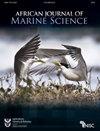南非水域菱形鳐Gymnura natalensis(菱形鳐科)的运动模式和捕获趋势
IF 1.4
4区 生物学
Q3 MARINE & FRESHWATER BIOLOGY
引用次数: 3
摘要
钻石鳐Gymnura natalensis是非洲南部的特有物种,在那里它喜欢浅水的海岸栖息地,这使得它很容易受到娱乐岸上钓鱼的影响。尽管它约占岸上标签数量的1%,但人们对其在南非的活动、繁殖或种群状况知之甚少。本研究使用了三个独立的长期(34-41年)数据集,包括休闲垂钓者的标记、竞争性岸钓渔获量和鲨鱼网渔获量,来调查南非的物种运动、渔获组成和种群状况。在被标记的3739只个体(1984-2018)中,只有30只(1%)在平均487天的自由后被重新捕获。大多数(60%)被捕获的海龟发生在距离放生地点10公里的范围内,而7%的海龟沿着海岸移动了1000多公里。记录的最长移动(1577公里和1756公里)是由在西开普省被标记的成年鳐鱼移动到夸祖鲁-纳塔尔省(KZN)进行的。竞争岸边钓鱼捕获(1977-2018;n = 9 150),以德班以北捕获的成鳐鱼为主;n = 584)以主要来自德班中心海滩的幼鱼为主。所有数据集都显示出强烈的季节趋势,大部分捕获发生在夏季。一项风险评估证实,在四代人的时间里,种群数量呈稳定增长趋势,这表明南非东海岸的种群样本应被列为最不值得关注的。本文章由计算机程序翻译,如有差异,请以英文原文为准。
Movement patterns and catch trends of the diamond ray Gymnura natalensis (Dasyatidae) in South African waters
The diamond ray Gymnura natalensis is endemic to southern Africa where its preference for shallow coastal habitats makes it vulnerable to recreational shore-based angling. Although it makes up approximately 1% of the shore-based tag numbers, little is known about its movements, reproduction or population status in South Africa. This study used three independent long-term (34–41 years) datasets, including tagging by recreational anglers, competitive shore angling catches and shark net catches, to investigate the species’ movements, catch composition and population status in South Africa. Of the 3 739 individuals tagged (1984–2018), only 30 (1%) were recaptured after an average of 487 days at liberty. The majority (60%) of the recaptures occurred within 10 km of the release site, while 7% had moved more than 1 000 km along the coast. The longest recorded movements (1 577 and 1 756 km) were undertaken by adult rays tagged in the Western Cape Province moving to KwaZulu-Natal Province (KZN). The competitive shore angling catch (1977–2018; n = 9 150) from KZN was dominated by adult rays caught north of Durban, while the shark net catch in KZN (1981–2018; n = 584) was dominated by juvenile rays primarily from the central beaches of Durban. All the datasets exhibited strong seasonal trends with most catches taking place in summer. A risk assessment confirmed a stable to increasing population trend over four generations, suggesting that the population sampled along the east coast of South Africa should be classified as Least Concern.
求助全文
通过发布文献求助,成功后即可免费获取论文全文。
去求助
来源期刊

African Journal of Marine Science
生物-海洋与淡水生物学
CiteScore
2.60
自引率
16.70%
发文量
17
审稿时长
6-12 weeks
期刊介绍:
The African (formerly South African) Journal of Marine Science provides an international forum for the publication of original scientific contributions or critical reviews, involving oceanic, shelf or estuarine waters, inclusive of oceanography, studies of organisms and their habitats, and aquaculture. Papers on the conservation and management of living resources, relevant social science and governance, or new techniques, are all welcomed, as are those that integrate different disciplines. Priority will be given to rigorous, question-driven research, rather than descriptive research. Contributions from African waters, including the Southern Ocean, are particularly encouraged, although not to the exclusion of those from elsewhere that have relevance to the African context. Submissions may take the form of a paper or a short communication. The journal aims to achieve a balanced representation of subject areas but also publishes proceedings of symposia in dedicated issues, as well as guest-edited suites on thematic topics in regular issues.
 求助内容:
求助内容: 应助结果提醒方式:
应助结果提醒方式:


